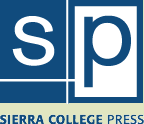History of Sierra College
by John McFarland
Former Sierra College History Professsor
Written in 1986
Sierra College's roots stretch back to the very beginning of the California Junior College movement. Had the initial Placer Junior College survived from its 1914 founding, Sierra would be the fourth oldest in the state. As it was, the first permanent effort - also in Auburn - occurred in 1936. Students enrolling this academic year are a part of the 51st class since that date.
Like most of the joint high school and junior college districts before 1945, Placer Junior College was a part of the far-flung Placer High School District, an enormous area encompassing almost all of Placer County from Loomis to the Nevada border.
Rural, rather than urban, (Auburn's population was 2600), Placer Junior College served students who were unable to make the four hour round-trip to small Sacramento State, and could not afford to live away from home. (Indeed, most of the early students did not expect to finish more than two years of college.)
The 1950s
In the 1950's Placer Junior College listed itself in the American Junior College Directory as "serving Sierra, El Dorado and Placer Counties." 15 district busses crossed high school lines to pick up college students in Nevada City, Roseville and Placerville. Since counties of origin were billed for the tuition their students cost, and since the additional students made a college possible in the first place, this effort was essential to Placer's survival. Most of the early instruction was by teachers borrowed from the high school. The college listed 32 instructors in 1940, but only three were full-time. Science and vocational education occurred almost entirely in high school buildings, though the college did acquire a building of its own by 1939.
Nearly all students attended full-time: 85 in 1936, 282 in 1939. Then two catastrophes beset the student body. Pearl Harbor all but ended enrollment by men, and the internment of Japanese Americans took a sizable ethnic population away. In 1943, only 53 students enrolled in the college, up to 119 in 1945. But, in February 1946, enrollment exploded to 467, nearly half of whom were veterans.
With little room for expansion, Placer College (the "Junior" having been dropped from its name during the War) would never again match the 1949 enrollment of 856 students while it remained in Auburn.
College and High School Separate
After the war, the College took steps for its independence. Until 1949, the chief college administrator had also been superintendent of the joint high school-college district. Then Harold Weaver took over the Presidency while having no administrative obligations to the High School.
Independence was made complete when, in 1961, the College moved to Rocklin and changed its name to Sierra. Auburn had rejected three efforts to move the campus away from the high school to nearby areas. But a bond measure succeeded when a district was proposed for the entire county, because the populous Roseville area provided the necessary votes. A few years later Nevada County joined a huge new Junior College District which until 1970 would have more square miles (3,200) than students.
Independence served Sierra well. It had a full-time faculty which could concentrate on one or two disciplines, as is appropriate in higher education. It would develop a college counseling staff, a library designed for college students, and an athletic program that did not have to share facilities with a high school.
More Faculty and Buildings
Within a decade of the move to Rocklin, Sierra had a faculty of 100 full-time instructors, nine buildings on its campus and 3,300 enrolled students.
The student body had begun to change, however. Whereas only a few part-time students enrolled during its first quarter century, the College would find at the end of its second quarter century that it had more part-timers than full-timers. And whereas 64% of students were men in 1954, 52% were women thirty years later. While about half the students in 1939 indicated that they planned on getting a baccalaureate degree, about 25% did during the early 1980s.
These figures, too, were subject to change. Sierra College no longer serves a largely rural and small-town population. Placer and Nevada Counties, for a decade now among the most rapidly growing in the State, have been urbanizing rapidly. In 1950, the principle industry in the District was the railroad. Now, a variety of light-industrial electronics firms have helped change the district economy. And freeways have opened both Southern Placer County and much of Nevada County to commuters who work in Sacramento. Sierra College's transfer rate is growing more rapidly than all but three of the districts in the state. And since 1980, two year degrees and certificates have increased three-fold. As its district and the broader society change, Sierra College has changed with it. The once-small Junior College enrolls nearly 10,000 students now on its own campus, in a fashion appropriate to higher education.
